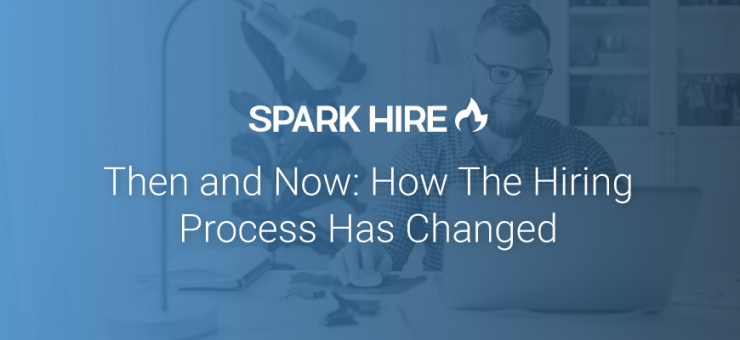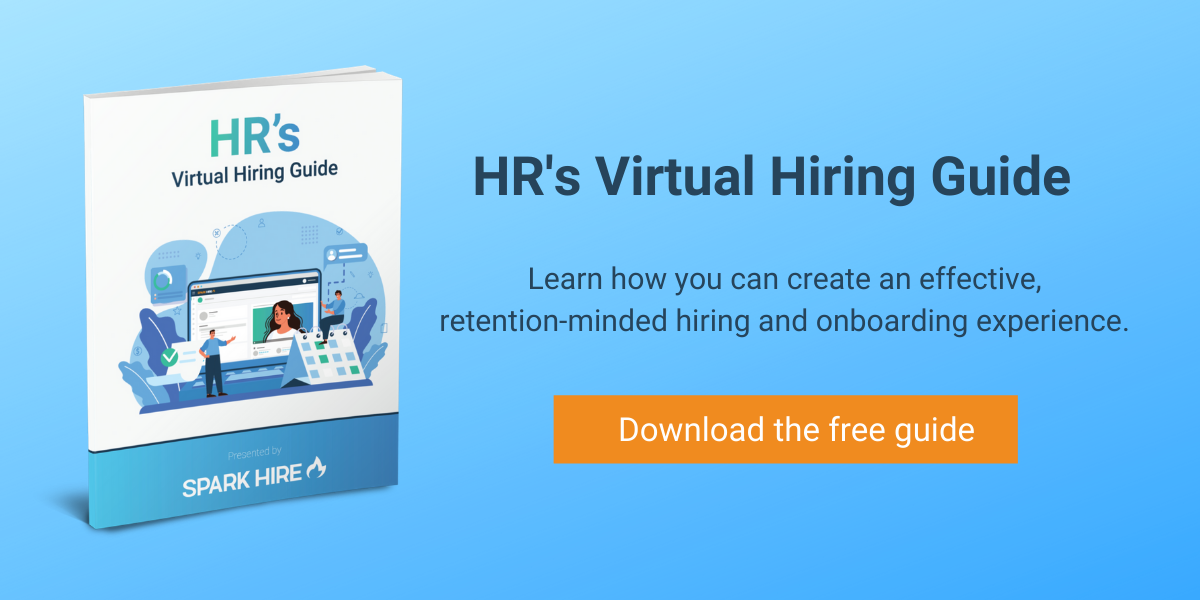The hiring process has transformed dramatically since the early 2000s. The processes are all so different that it’s wild to realize what seems common now (like LinkedIn, video messages, and texting) didn’t exist in the same capacity only two decades ago. And this change is due to rapid technological advancements.
Beyond just the rise of the internet, tools like video interviewing and interview scheduling software have helped streamline the hiring process, saving both time and money, all while making hiring managers’ jobs much easier.
But there are some other, more subtle, differences between how people acquire talent now versus two decades ago.
Let’s take a look at all the ways–big and small– the hiring process has shifted:
Your reach is much more expansive
Before social media and the internet, a person looking to expand their team had to hope that a qualified professional saw their job posting in the local newspaper or a trade magazine.
Their reach was fairly limited when it came to hiring, and hiring managers often found they were talking to the same candidates over and over when it came time to fill a job — or worse, choosing less-than-qualified individuals for open roles, simply because they had no one else available to them.
The internet has truly revolutionized hiring. There are so many more touchpoints available to a hiring manager looking to fill an open role. From LinkedIn to your company’s website to Twitter, Facebook networking groups, and beyond, it’s never been easier to access a deep pool of qualified candidates.
In some ways, this might feel overwhelming, as it means you’re sorting through more resumes than ever before, but it also greatly increases your chances of finding someone who’s the perfect fit for the role in question. You have more opportunities to find candidates outside of just your town. And their social media accounts provide you even more information about them.
Networking happens in many different places
Of course, as a hiring pro, you know that networking is a great way to get more leads during the hiring process and receive referrals for top talent.
In the pre-internet era, networking happened at stiff post-work events with bad hors d’oeuvres and watered-down drinks. If you weren’t present at these events, you were missing out on your chance to meet the most promising group of professionals your area had to offer.
Now, thanks to sites like LinkedIn, Twitter, and even Facebook and Instagram, networking has taken on a completely different feel. It can happen anytime and anywhere and has become a much more casual concept.
This opens up possibilities of meeting people from different places and walks of life. It also moves the focus away from business cards and toward genuine dialogues with other professionals.
This is huge for the job market. When job seekers have a stronger network, they have so many more opportunities for finding openings and getting referrals. Talentegy’s 2019 Candidate Experience Report shows that, when workers consider a job change, 74.5% said that job boards are one of the top resources they use, and 55.6% selected their professional social networks.
There’s a greater emphasis on employer branding
With the rise of the internet, it’s become easier than ever for job seekers to gather information about the companies where they apply.
What kinds of clients does this company typically work with? Based on pictures, blog posts, tweets, and homepage content, what kind of atmosphere does the office seem to exude? Your online presence can either attract or deter talent, so invest time into using these resources wisely.
If you’re a creative firm, use social media and your website to show off that creativity and attract job seekers who want to be in a place where their ideas are allowed to blossom. If you’re a business with plenty of structure, use your online content to make this clear so you can attract talent that value this stability.
Furthermore, you want to make sure your messaging is consistent across all platforms and that it’s properly reflecting what the company is all about. This ensures you attract the right talent.
It’s much easier to schedule interviews
In years past, hiring managers had to engage in a constant back and forth with candidates as they tried to find a time to bring them in for an interview. This became a time-consuming and tedious process, often resulting in frustration for both parties.
Throw in time zone differences and the task became a nightmare, often deterring hiring managers from opting to work with candidates outside a close radius.
Thanks to the arrival of interview scheduling software on the scene, you are now able to take the legwork out of bringing a professional in for an interview. This enables them to shift their attention to preparing for the interview and making the best hiring choice possible for the business.
The growing popularity of one-way interviews also reduces time pressures on hiring pros. Rather than tediously matching their schedule to candidates’ and building their days around countless interviews, they can watch recordings whenever it best fits into their day.
Overall, it makes it much easier to promote flexibility and productivity in your hiring process.
Drastic improvements in video interviewing technology
Video interviewing has become a dramatic time and money saver for those looking to hire. Even as early as 2010, major outlets like SHRM recognized how the cost of a video interview platform saved significant amounts of money compared to travel costs.
Instead of having to fly a candidate in for an interview or rely on the phone to get a sense of what this person is all about, you can now utilize video interviewing technology. This enables them to hear and see what the professional is all about without having to pay for airfare and hotel costs.
Furthermore, video interviews are a reliable alternative in times that it isn’t safe for employees’ health to have candidates entering the office in-person.
Additionally, video interviewing technology itself has become much more accessible since it first became available. What was once a high-priced system is now affordable for businesses of all sizes.
The quality of technology is much better now too. You can see and hear the individual on the other end of the system without worrying about the system dropping out every few minutes. No more fuzzy video!
Candidates run the show
Today, job seeking has become much more tailored to the candidate’s experience, particularly when vying for top-tier talent. You may have realized that if you want the attention of a valuable would-be employee, you can’t make them bend over backward to move through your hiring process.
The video interview is one change that benefits candidates. Instead of forcing them to take time off from work, they’re able to record an interview from the comfort of their own home at a time that works for them. This shows that you respect their time.
Additionally, many hiring managers have become focused on moving through the hiring process as quickly as possible.
Years ago, candidates could wait months to hear back about whether they landed a second or third-round interview. This put job searches into a constant, frustrating limbo and wasted many candidates’ time.
Now, people tasked with hiring realize the importance of being transparent with applicants. They want to find the best candidate for the open role as quickly as possible out of respect for everyone’s time.
From beginning to end, the average time it takes to fill an opening is 38 days according to Jobvite’s 2019 Recruiting Benchmark Report. Determine the SLA that works best for your company and team, and hold yourselves to that standard.
The kind of employee hiring managers want has changed
Regardless of the industry, many hiring managers are realizing just how rapidly business is changing. The way the overall company-operated twenty years ago should be drastically different than the way things are now. And that means the type of employee you’re looking to hire should have shifted along with it.
Technical skills will never go out of style, but there is more emphasis on soft skills today. Hiring pros want to know that individuals joining the team can pivot, learn new skills, and adapt to a changing business environment. They need to be open to learning new technology and new ways of reaching their customers.
Those who insist on sticking with the same old way things have always been done just because it’s comfortable will plateau and, eventually, get left in the dust. As good as they might be at a job, for now, they’re not the best long-term investment.
An increased focus on cultural fit
Between the early 2000s to today, there has been a significant shift in what job seekers and hiring pros prioritize in the job market.
Of course, those looking for career advancement still care about salary, benefits, and time off. They want to ensure they’ll be compensated fairly for their time and treated well, should they accept an offer.
However, job seekers have also taken a deep interest in the company culture. What are the current employees like? What values matter most to upper management? Is work completed collaboratively or individually? Do they allow team members to work from home?
From a hiring manager’s perspective, experience and education matter, but they’re also taking a deeper look at who that candidate is as an individual.
Pros in charge of the hiring process now recognize that a candidate’s attitude is just as important to consider as their qualifications. If they’re going to cause tension among clients or with veteran employees, it may be best to look at other candidates.
One person directly contributes to the morale of the entire company, so choosing someone who will both fit in well and add to the culture is essential.
There’s a greater focus on data and analytics
Hiring managers also realize they can use data to pick up on patterns and predict future success when it comes to expanding their team. They can look at everything from the responses a person gave during their video interview to their training and educational background. These pieces of information can help predict which candidates will be successful in the future.
Instead of guessing the type of individual who will make the best addition to the team and hoping they’re right, like many hiring managers, you’ve likely come to rely heavily on facts and figures to guide their choices as they pertain to the hiring process.
The increase in available data has also enabled it to become a more accurate hiring process all around.
If you ever feel overwhelmed in your position as a hiring manager, just remember that feeling is justified. With the speed at which systems and processes are changing, trying to keep up is naturally a stressful endeavor!
Advancements in technology change fast, they change everything, and they’re going to keep on doing just that for the next several decades to come.
If you ever start to feel like it’s too much, take another look at this list. No matter how frustrating it can be to wrestle with tech, we can’t forget how much better it makes the process, the candidate’s experience, and the overall quality of employees.












